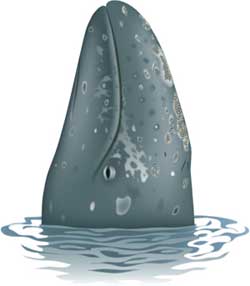Monthly Speaker Series: 2014-2015
The Puget Sound Chapter of the American Cetacean Society would like to sincerely thank the following people for giving a presentation at one of our monthly Speaker Series meetings.
Click on any of the Abstract links for a summary and a brief bio about the talk Many abstracts also contain additional related resources.
17 June 2015 - Dr. Kate Stafford, Applied Physics Lab, UW
A Tale of Three Straits: acoustic detections of summer and winter whales in the Pacific and Atlantic Arctic ... Abstract
The loss of Arctic sea ice has become an iconic signal of global climate change. Changes in sea ice phenology have been profound in regions north of arctic gateways where the seasonal open-water period has increased by 1.5-3 months over the past 30 years. This has resulted in changes to the Arctic ecosystem including increased primary productivity, changing food we structure, increased anthropogenic use, and opening of new habitat for subarctic marine mammals. Sub-arctic “summer” whales (fin and humpback) seem poised to inhabit new seasonal ice-free habitats in the Arctic.
To determine the spatial and seasonal occurrence of summer and “winter” (bowhead) whales acoustic data from three Arctic gateways: Bering, Davis and Fram Straits, were used and acoustic occurrence of the three species of whale were compared with decadal-scale changes in seasonal sea ice.
There was spatial, but not temporal overlap in summer and winter whales in these gateways. At present, then, large whales, unlike ice seals, polar bears and walrus, may not be on thin ice. However, in a future with even less sea ice, competition for prey, competition for “acoustic space”, and increased noise, ship strikes and oil spills due to commercialization of the Arctic may become issues for humpback, fin, and bowhead whales.
Dr. Kate Stafford is a principal oceanographer at the Applied Physics Lab, University of Washington. She has studied large whales from pole-to-pole. Her current research focus is on Arctic bioacoustics and how the changing climate is impacting the phenology of Arctic and sub-Arctic marine mammals.
20 May 2015 - Candice Emmons, NWFSC/NOAA
Killer Whales in Winter - Recent Findings about Range, Diet, and Behaviors ... Abstract
This past winter researchers recently spent 21 days aboard the NOAA ship Bell M. Shimada, tracking endangered Southern Resident killer whales (SRKWs) off the coasts of Washington and Oregon. Good weather and ocean conditions allowed researchers exceptional access to the whales, including the first sighting of new calf L121, during their winter foraging period.
Candice will give an overview of this survey and its role in addressing a major gap in our understanding of SRKWs life history—where these whales go during the winter, what they do, and what they eat.
Candice Emmons joined the Northwest Fisheries Science Center in June of 2006 and she currently works on a variety of projects including winter habitat use and foraging ecology of Southern Resident killer whales. She earned a B.S. in Biological Sciences with an emphasis in the Marine Sciences from California State University Northridge and a Master's degree in Marine Affairs from the University of Washington. Candice is also a board member of ACS/PS.
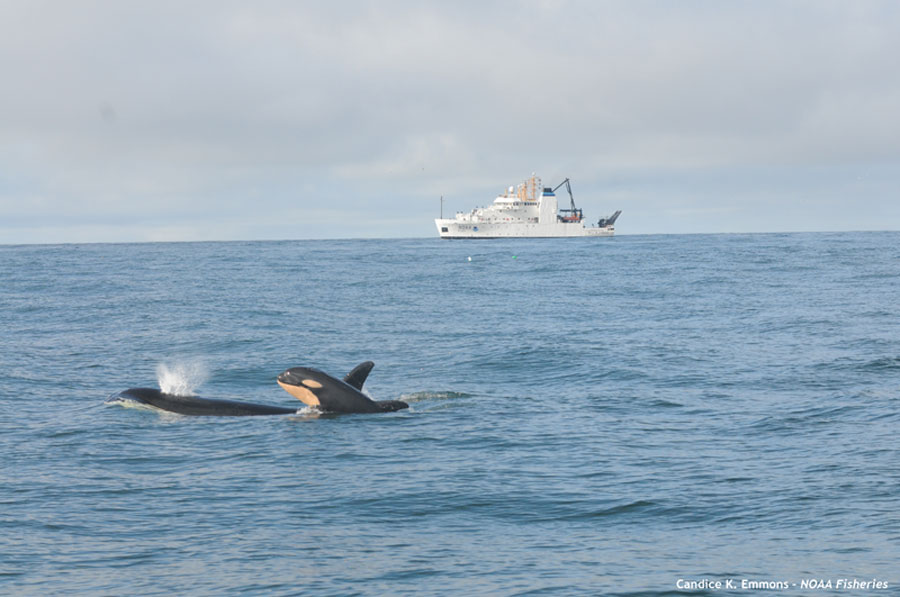
22 April 2015 - Dr. Tomas A. Jefferson
A Tale of Two Porpoises: Extinction Looms, but Recovery is Possible ... Abstract

This talk will focus on two North American species of porpoises. The harbor porpoise (Phocoena phocoena) is common along all the cooler coastlines of North America, and the local population in the inland waters of Washington has recently recovered and is now reoccupying its historical range in Greater Puget Sound. In contrast, the vaquita (Phocoena sinus), its relative in the northern Gulf of California, Mexico, is being decimated by catches in gillnets. It is the most endangered species of marine mammal on the planet, with only about 83 animals left! Tom will discuss these two stories, both of which he has been involved in, and evalute the prospects for other vulnerable species of small cetaceans.
Tom Jefferson has studied marine mammals since 1983. His main interests are the development of marine mammal identification aids, and the systematics and population ecology of the more poorly-known species of dolphins and porpoises. Jefferson’s work for the past three decades has been related to conservation and management of marine mammals threatened by human activities. Since 1995, he has worked in Southeast Asia, and has traveled widely in the region. His current primary research focuses on the conservation biology of Indo-Pacific humpback dolphin (Sousa chinensis) and finless porpoise (Neophocaena phocaenoides) populations in Hong Kong and surrounding waters. Other projects Tom Jefferson has been involved with is looking at the systematics and ecology of these species throughout their ranges, as well as the conservation of the critically-endangered vaquita (Phocoena sinus) and on the taxonomy and population ecology of common dolphins (Delphinus spp.). With co-authors, Marc Webber and Robert Pitman, Tom has published a comprehensive identification guide to the marine mammals of the world (Academic Press, 2008). A second edition is due to be published this year.
18 March 2015 - on hiatus
abstract
speaker ipsem
18 February 2015 - Howard Garrett, Orca Network
Returning an orca to her home while helping her family find food ... Abstract
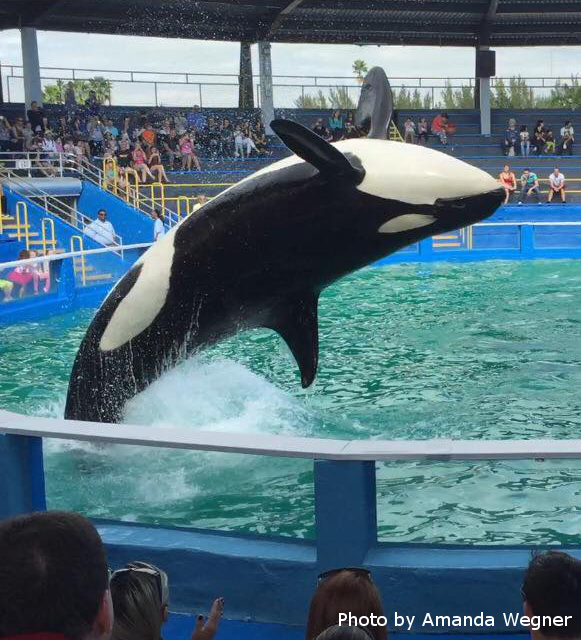
Since 1995 a campaign has been underway to return a long-term captive L pod orca to her native habitat and possibly to her extended family. Despite broad local support the proposal for Lolita's retirement didn't have much effect on the marine park in Miami until very recently. Now a multi-pronged legal effort, reinforced by heightened national and international backing, may be on the verge of leveraging Lolita back to her home and family. The Southern Resident orcas, meanwhile, are experiencing their own problems, especially the lack of sufficient chinook salmon. We'll talk about new assessments of the economic value of the four lower Snake River dams and how to improve chinook spawning and survival to help Southern Resident orcas successfully reproduce, and how Lolita's return could amplify those efforts.
Howard Garrett, B.A., Sociology, began studying orcas with the Center for Whale Research in 1981. He was a naturalist aboard whale watching boats in the San Juan Islands and New England until 1993. In 1995 he started the Tokitae Foundation to return Lolita to her home in the Salish Sea. He co-founded Orca Network with his wife Susan Berta in November 2001 to provide education about the whales of the Salish Sea and advocacy for habitat protection and restoration.
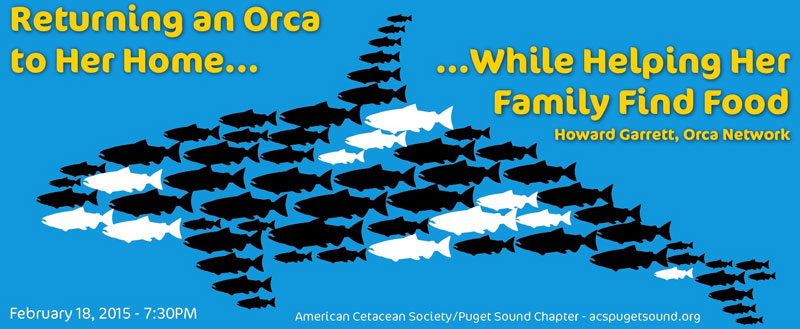
21 January 2015 - Kristin Wilkinson, NOAA Stranding Coordinator
Marine Mammal Strandings in Washington and Oregon Abstract
Kristin will talk about marine mammal strandings in Washington and Oregon and will give a brief overview of the stranding program. Some recent marine mammal stranding cases will be discussed along with a review of marine mammal species that can be frequent our waters.
Kristin Wilkinson has been working for NOAA Fisheries for the past 8 1/2 years. She attended James Cook University in Townsville, Australia and graduated with a degree in Conservation of Marine Ecosystems and Marine Mammal Education from the University of Hawaii, Manoa. Kristin lives with her husband and 7 year old daughter in Edmonds.
19 November 2014 - Uko Gorter, Natural History Illustrator
Cetacean Celebration! The Diversity of Whales, Dolphins, & Porpoises Abstract
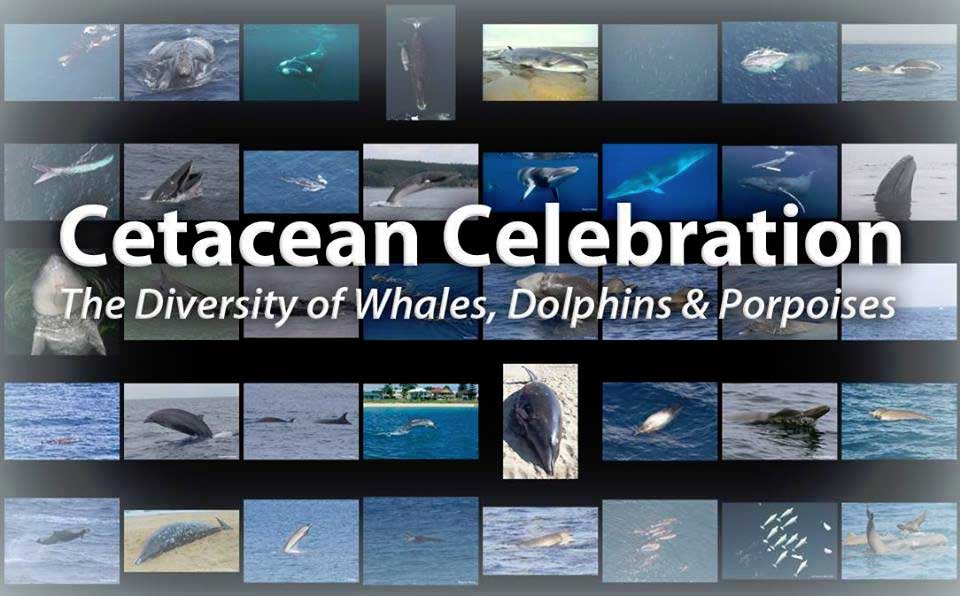
Come join us for a trip around the world and celebrate the incredible diversity of the Order of Cetacea. We will be showing a selection of stunningly beautiful and jaw-dropping photos of all 90 species (plus a few subspecies).
The photos are just a teaser for the upcoming (2015) publication of Marine Mammals of the World: A Comprehensive Guide to their Identification, authored by Tom Jefferson, Marc Webber, Bob Pitman, illustrated by Uko Gorter, and published by Elsevier/Academic Press.
Enjoy the splendor and differences of all baleen and toothed whales; test your knowledge; and just have some fun at this last meeting of the year!
14 October 2014 - Yulia Ivashchenko, National Marine Mammal Laboratory, Seattle
Too much is never enough: The Cautionary tale of Soviet Whaling Abstract

Despite being a signatory to the International Convention for the Regulation of Whaling (1946), the USSR conducted a 30-year campaign of illegal whaling which arguably represents one of the greatest failures of management in the history of the industry. In this talk, using a variety of sources including published literature, formerly secret Soviet industry reports and interviews with former biologists and whalers, I will provide an overview of the history, scope, and economic origins of Soviet whaling, and examine the domestic and international political context in which it was set.
At various times during the period from 1933 into the 1970’s, the USSR operated a total of seven whaling factory fleets and several shore whaling stations. I estimate that 534,119 whales were killed, of which 178,726 were not reported to the International Whaling Commission (IWC). In the Southern Hemisphere, the greatest impact of these catches was on humpback whales, Megaptera novaeangliae, where (mostly illegal) takes of more than 48,000 whales precipitated a population crash and closure of shore whaling stations in Australia and New Zealand. The Southern Hemisphere also saw large illegal catches of southern right whales (Eubalaena australis). In the North Pacific, the greatest impacts were on sperm whales, Physeter macrocephalus, (where data on sex and length were routinely misreported together with falsified total catches), as well as on the two already-small populations of right whales, Eubalaena japonica, across the North Pacific and bowhead whales, Balaena mysticetus, in the Okhotsk Sea.
Soviet whaling was driven by the state industrial planning system, which frequently set high production targets without regard to the ability of the resource to sustain the resulting large catches. I trace the evolution of the USSR’s public stance at the IWC while the nation was illegally whaling, and summarize its evolving positions on major issues, including catch limits, national quotas, the status of whale populations, and the International Observer Scheme (which the USSR opposed for many years, for reasons that are now obvious). I examine the ways in which the USSR and other nations exploited weaknesses in the Convention to block or delay decisions unfavorable to the industry.
It is clear that many at IWC knew that the USSR was whaling illegally, but they were probably unaware of the large scope of this activity. It is also clear that the Soviets were not alone in falsification of catch data, a problem which underscores the inadequacy of the IWC’s existing procedures for inspection and enforcement with regard to current and possible future commercial whaling.
Yulia Ivashchenko is a guest scientist who works on large whale issues for NMML's Cetacean Assessment and Ecology Program. Her current research interests include bowhead whales in the Okhotsk Sea, as well as North Atlantic and North Pacific humpback whales. Yulia has recently translated into English formerly secret scientific documents relating to the massive campaign of illegal whaling conducted by the former U.S.S.R. from 1948 to 1972. In collaboration with the Russian and Ukrainian biologists who worked aboard Soviet whaling factory ships during this time, she has helped to establish a true catch record for use in population assessments, and is currently planning an oral history project to document the details and context of the illegal hunts. Yulia became a member of the scientific crew for a NMML study of North Pacific right whales in the Bering Sea beginning in July 2007.
17 September 2014 - Meegan Corcoran
U.S. Navy Sonar and Marine Mammals: Potential Measures to Mitigate Harmful Effects Abstract
National security and environmental health have been at odds in the United States for decades. A prominent example is the competing interests regarding Naval active sonar and the potential impacts to marine mammals. Naval sonar is essential for submarine identification and tracking and to deter threats. However, active sonar has been correlated to behavioral changes, deafness, hemorrhaging, stranding, and death of marine mammals throughout the oceans.
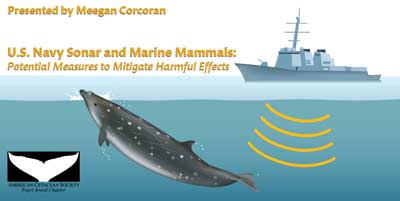
The U.S. Navy is currently proposing to increase sonar testing and training off the Pacific Northwest coast and within the Puget Sound. The Navy presently employs several marine mammal mitigation measures in order to limit negative impacts. However, these measures are highly scrutinized for lack of effectiveness. Additional mitigation measures exist that may be utilized by the Navy to further decrease harm. During this talk, Meegan Corcoran will discuss in detail five additional measures which support national security while increasing protection to marine mammals. It is imperative the Navy assess alternative measures to increase environmental protection while maintaining military readiness standards.
Meegan served as a sonar technician in the United States Navy for eight years during which time she worked primarily with Low-Frequency Active (LFA) sonar. Given her firsthand experience, she became inspired to develop operation standards that protect citizens and marine mammals simultaneously. She has now been working on this issue for over a decade. Meegan currently lives in Friday Harbor and hopes to invoke change not only within U.S. military but foreign and NATO forces as well.

